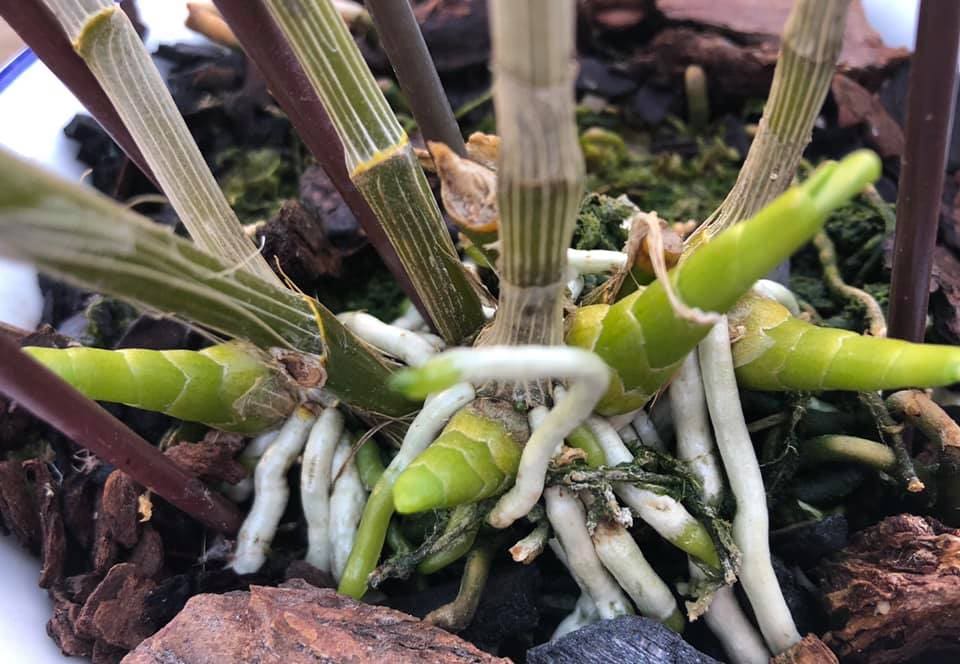Kelpak is a remarkable plant growth stimulant that can help weak plants recover, grow new or better root systems, bloom and produce more fruit, and multiply more quickly. It has been shown to accelerate pollen-tube growth leading to more complete penetration of the ovary and the production of more fruit, and can accelerate the germination of seeds, as well.

Kelpak has been used of food- and fruit crops, grains, turf and landscaping plants for 40 years or more. I brought it to the orchid community in 2011, and have expanded its use to tropical houseplants, annuals, perennials, garden vegetables and herbs, and in consultation with the producer, can offer the following usage advice that is applicable to most-, if not all cultivated plants.
First and foremost, Kelpak is NOT a fertilizer, but is better thought of as a fertilizer supplement. Yes, it does contain a wide variety of nutrient elements, but its benefits stem primarily from the complex polyamines, carbohydrates, vitamins, alginates, phlorotannins, and an array of other plant growth regulators. It does contain a minor level of auxins as well, but the degree of stimulation resulting from its use is far beyond what one would expect from the hormones alone. In a discussion with the producers, I recently described the product as a “plant I.V.” – a fluid that contains all the things a plant ordinarily produces for itself, but by getting them from an external source, it reinforces the plant without it having to expend its own resources to do so. They confirmed that to be a good way to look at it, but stressed that one still needs to keep up the regular fertilizer regimen to provide the raw materials needed to support that improved growth.
For routine use, the product should be used at a 1:250 dilution (1 tablespoon/gallon, 4 milliliters/liter), and applied once per month. If you have a plant that is struggling, it is safe to temporarily apply it a few times at two-week intervals (I have never needed to do that more than twice) or give the plants a single treatment at double that dosage rate. Diluting it to 1:500 or greater renders it ineffective. Many orchid growers, for example, are used to cutting back on fertilizer concentration while applying it more frequently, but stimulants don’t work that way. With growth stimulants, there is a critical, minimum concentration for them to activate processes in plants; below that, a treatment does nothing. I liken it to operating a light dimmer switch. Apply too little pressure and nothing happens. Apply the right pressure, the switch moves and the lights start to come on. Apply more pressure and the lights get brighter, but there is an upper limit, so applying more pressure does nothing – the light certainly does not get brighter! – and you risk breaking it.
Plants that have been given the “Kelpak I.V.” have all of their processes accelerated, including the normal physiological cycling of plant hormones. As the root apical meristem (growth front) expands, the cells secrete cytokinins that move upward in the vascular system to stimulate the growth of the plant shoot. As the shoot apical meristem grows, it emits auxins that travel down the vasculum and stimulate root growth. Think of it like a steadily burning campfire – throw a little gasoline on it and it flares up for a few minutes, then slowly subsides back to its normal level. In stimulated plants, it typically takes between two- and three weeks for the “flare up” to return to normal levels, which is why we recommend waiting a month between treatments, for the most part. However, as the stimulating effect of Kelpak is not reliant solely on hormones, it is safe to temporarily “up” the treatment. If that is done with products based upon hormones, overapplication can lead to deformed growth and flowers, stunted growth, or even death.
Using Kelpak at the right concentration and frequency is as much about economy as it is plant health, but there are circumstances for which we can “push the boundaries” a bit:
PLANTS WITH NO ROOTS
- Using warm water, mix the solution and immerse the entire plant for an hour or two.
- Without rinsing, pot it up, and water it in with that soak solution.
- For the next two waterings, add Kelpak at the recommended concentration.
REPOTTING PLANTS WITH DECENT ROOT SYSTEMS
- Pot them up and water them in with Kelpak solution.
- Repeat the next two waterings.
EXISTING, ESTABLISHED PLANTS (AND THOSE ABOVE, AFTER THE RECOMMENDED TREATMENTS)
- Add to irrigation water or fertilizer solution no more often than once per month.
